Arc Plasma Flow Variation by Obstruction Structures between Anode and Cathode
Abstract
:1. Introduction
2. Arc Plasma Model
2.1. Assumptions
- (1)
- We focused on arc plasma flow variations and used 2D axisymmetric and spatial coordinates (cylindrical) to form geometries;
- (2)
- Argon was used as the shielding gas and the flow was laminar and steady-state;
- (3)
- Influence of metal vapor on the transport properties of argon gas is not considered;
- (4)
- The arc plasma was considered to be in LTE to avoid the need for the development of a twin temperature model for the modelling of the arc plasma area [21];
- (5)
- Changes in the weld pool and electrodes were not considered.
2.2. Governing Equation
2.2.1. Electric Currents
2.2.2. Magnetic Fields
2.2.3. Heat Transfer
2.2.4. Laminar Flow
2.3. Boundary Conditions
3. Results
3.1. Arc Plasma Analysis for the Different Current
3.2. Variation of High Temperature Arc Plasma Flow via Obstruction Structure between Electrodes
4. Conclusions
Author Contributions
Funding
Institutional Review Board Statement
Informed Consent Statement
Data Availability Statement
Acknowledgments
Conflicts of Interest
Nomenclature
| A | magnetic vector potential |
| Richardson’s constant | |
| B | magnetic flux density |
| fluid heat capacity at constant pressure | |
| E | electric field intensity |
| F | volume force vector |
| H | magnetic field intensity |
| J | current density |
| externally generated current density | |
| ion current density | |
| electron current density | |
| k | fluid thermal conductivity |
| Boltzmann’s constant | |
| p | pressure |
| q | electronic charge |
| Q | heat source |
| heat flux on cathode boundary | |
| current source | |
| S | strain-rate tensor |
| T | absolute temperature |
| u | the fluid velocity vector |
| v | velocity of the conductor |
| V | scalar electric potential |
| ionization potential of the plasma | |
| electrical conductivity | |
| surface work function | |
| effective work function | |
| dynamic viscosity | |
| density | |
| viscous stress tensor |
References
- Wu, C.S.; Ushio, M.; Tanaka, M. Modeling the anode boundary layer of high-intensity argon arcs. Comp. Mater. Sci. 1999, 15, 302–310. [Google Scholar] [CrossRef]
- Lee, W.H.; An, J.H.; Byeon, S.S.; Lee, J.C. Prediction on plasma behavior of free-burning arc systems by numerical analysis of three-dimensional thermal flows. In Proceedings of the KIEE Summer conference, Pyeongchang, Gangwon-do, Korea, 13–15 July 2016. [Google Scholar]
- Bauchire, J.M.; Langlois-Bertrand, E.; Izarra, C.D. Numerical modelling of a free-burning arc in argon: A tool for understanding the optical mirage effect in a TIG welding device. In Proceedings of the COMSOL Conference, Milan, Italy, 7–9 October 2009. [Google Scholar]
- Lago, F.; Gonzalez, J.; Freton, P.; Gleizes, A. A numerical modelling of an electric arc and its interaction with the anode: Part I. The two-dimensional model. J. Phys. D Appl. Phys. 2004, 37, 883–897. [Google Scholar] [CrossRef]
- Savas, A.; Ceyhun, V. Finite element analysis of GTAW arc under different shielding gases. Comp. Mater. Sci. 2011, 51, 53–71. [Google Scholar] [CrossRef]
- Murphy, A.B.; Tanaka, M.; Yamamoto, K.; Tashiro, S.; Sato, T.; Lowke, J.J. Modelling of thermal plasmas for arc welding: The role of the shielding gas properties and of metal vapour. J. Phys. D Appl. Phys. 2009, 42, 194006. [Google Scholar] [CrossRef]
- Tashiro, S.; Tanaka, M.; Nakata, K.; Iwao, T.; Koshiishi, F.; Suzuki, K.; Yamazaki, K. Plasma properties of helium gas tungsten arc with metal vapour. Sci. Technol. Weld. Joi. 2007, 12, 202–207. [Google Scholar] [CrossRef]
- Tanaka, M.; Lowke, J.J. Predictions of weld pool profiles using plasma physics. J. Phys. D Appl. Phys. 2007, 40, R1–R23. [Google Scholar] [CrossRef]
- Hsu, K.C.; Etemadi, K.; Pfender, E. Study of the free-burning high-intensity argon arc. J. Appl. Phys. 1983, 54, 1293–1301. [Google Scholar] [CrossRef]
- Haddad, G.N.; Farmer, A.J.D. Temperature determinations in afr ee-burning arc: 1. Experimental techniques and results in argon. J. Phys. D Appl. Phys. 1984, 17, 1189–1196. [Google Scholar] [CrossRef]
- Lee, W.H.; Kim, Y.J.; Lee, J.C. Temperature prediction in a free-burning arc and electrodes for nanostructured materials and systems. J. Nanosci. Nanotechnol. 2015, 15, 8446–8450. [Google Scholar] [CrossRef] [PubMed]
- Lee, J.H.; Cho, Y.T.; Na, S.J. A numerical analysis of a gas-tungsten arc welding considering the current density and temperature distribution on the electrode surface. Proceedings of Institution of Mechanical Engineers. Part B. J. Eng. Manuf. 2002, 216, 1115–1121. [Google Scholar] [CrossRef]
- Cho, Y.T.; Cho, W.I.; Na, S.J. Numerical analysis of hybrid plasma generated by Nd:YAG laser and gas tungsten arc. Opt. Laser. Technol. 2011, 43, 711–720. [Google Scholar] [CrossRef]
- Cho, Y.T.; Na, S.J. Numerical Analysis of Plasma in CO2 Laser and Arc Hybrid Welding. Int. J. Precis. Eng. Man. 2015, 16, 787–795. [Google Scholar] [CrossRef]
- Mokrov, O.; Simon, M.; Sharma, R.; Reisgen, U. Arc-cathode attachment in GMA welding. J. Phys. D Appl. Phys. 2019, 52, 1–9. [Google Scholar] [CrossRef]
- Dong, B.; Cai, X.; Ni, Z.; Lin, S.; Fan, C.; Yang, C. Numerical simulation of arc characteristics in narrow gap TIG welding. Int. J. Mech. Sci. 2019, 10503, 161–162. [Google Scholar] [CrossRef]
- Xiang, J.; Chen, F.F.; Park, H.; Tanaka, K.; Shigeta, M.; Tanaka, M.; Murphy, A.B. Numerical study of the metal vapour transport in tungsten inert-gas welding in argon for stainless steel. Appl. Math. Model. 2020, 79, 713–728. [Google Scholar] [CrossRef]
- Trelles, J.P. Nonequilibrium Phenomena in (Quasi-) thermal Plasma Flows. Plasma Chem. Plasma Process. 2019, 40, 727–748. [Google Scholar] [CrossRef]
- Xu, G.; Hu, J.; Tsai, H.L. Three-dimensional modeling of arc plasma and metal transfer in gas metal arc welding. Int. J. Heat Mass Tran. 2009, 52, 1709–1724. [Google Scholar] [CrossRef]
- Cai, X.; Dong, B.; Lin, S.; Fan, C.; Yang, C. Numerical analysis of arc physical properties in narrow gap. TIG welding. Int. J. Adv. Manuf. Technol. 2020, 106, 5509–5517. [Google Scholar] [CrossRef]
- Traidia, A. Multiphysics Modelling and Numerical Simulation of GTA Weld Pools. Ph.D. Thesis, Ecole Polytechnique, Paris, France, 2011. [Google Scholar]
- COMSOL Multiphysics Version 5.4 User’s Guide; COMSOL, Inc.: Grenoble, France, 2018.
- Yamamoto, K.; Tanaka, M.; Tashiro, S.; Nakata, K.; Murpy, A.B. Numerical Simulation of Metal Vapor Behavior in Argon TIG Welding. Trans. JWRI 2007, 36, 1–4. [Google Scholar]
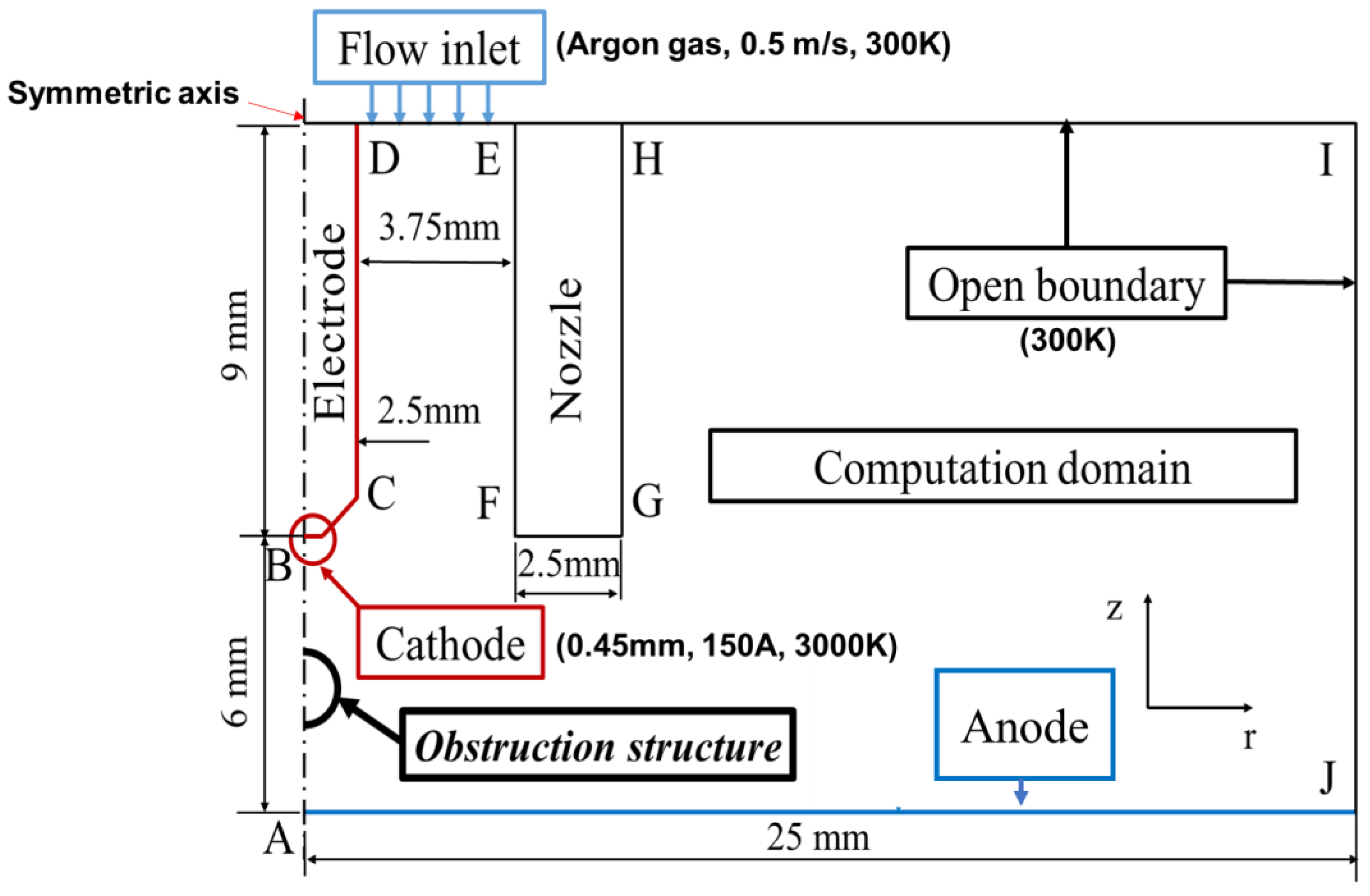

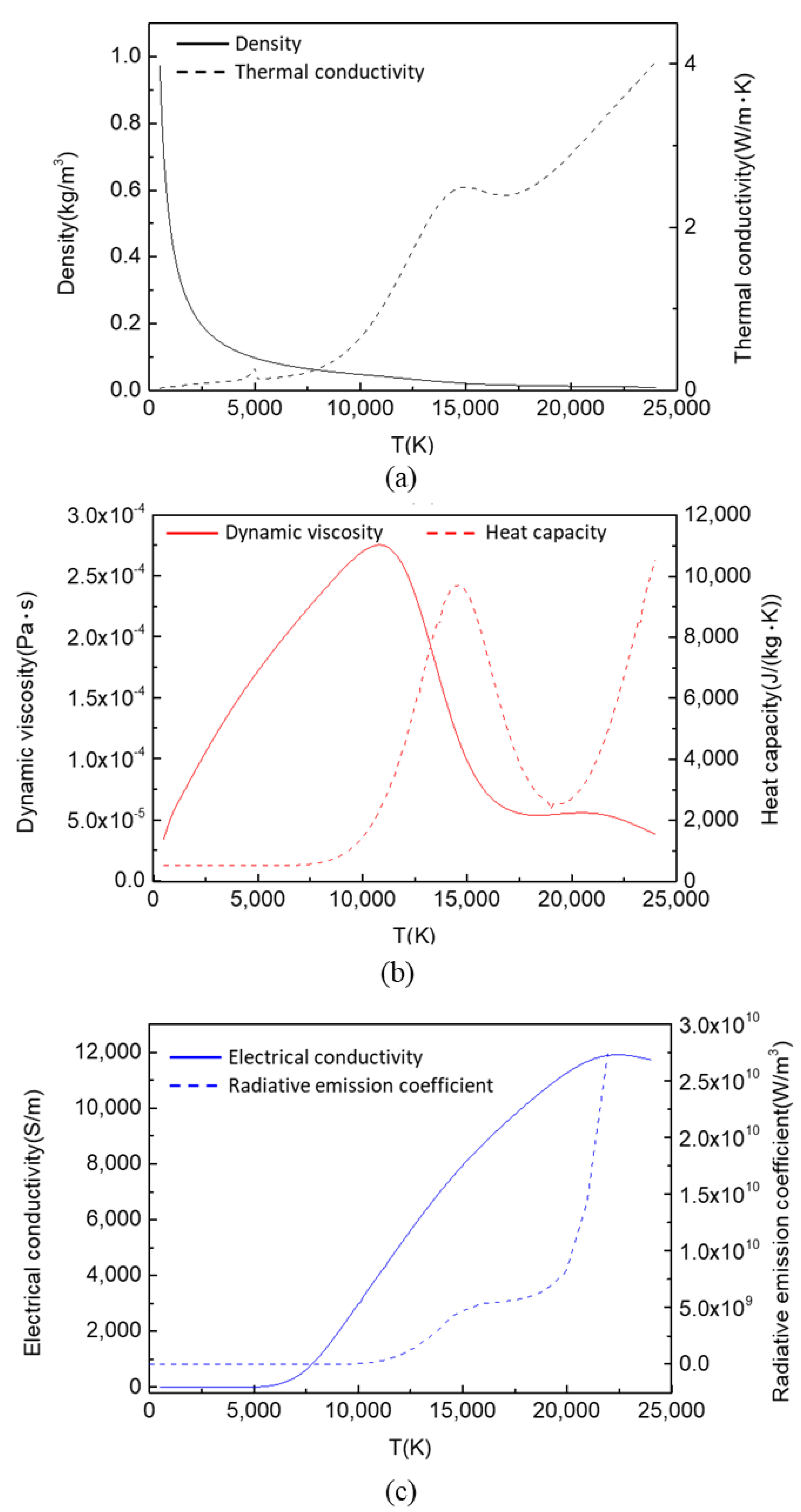
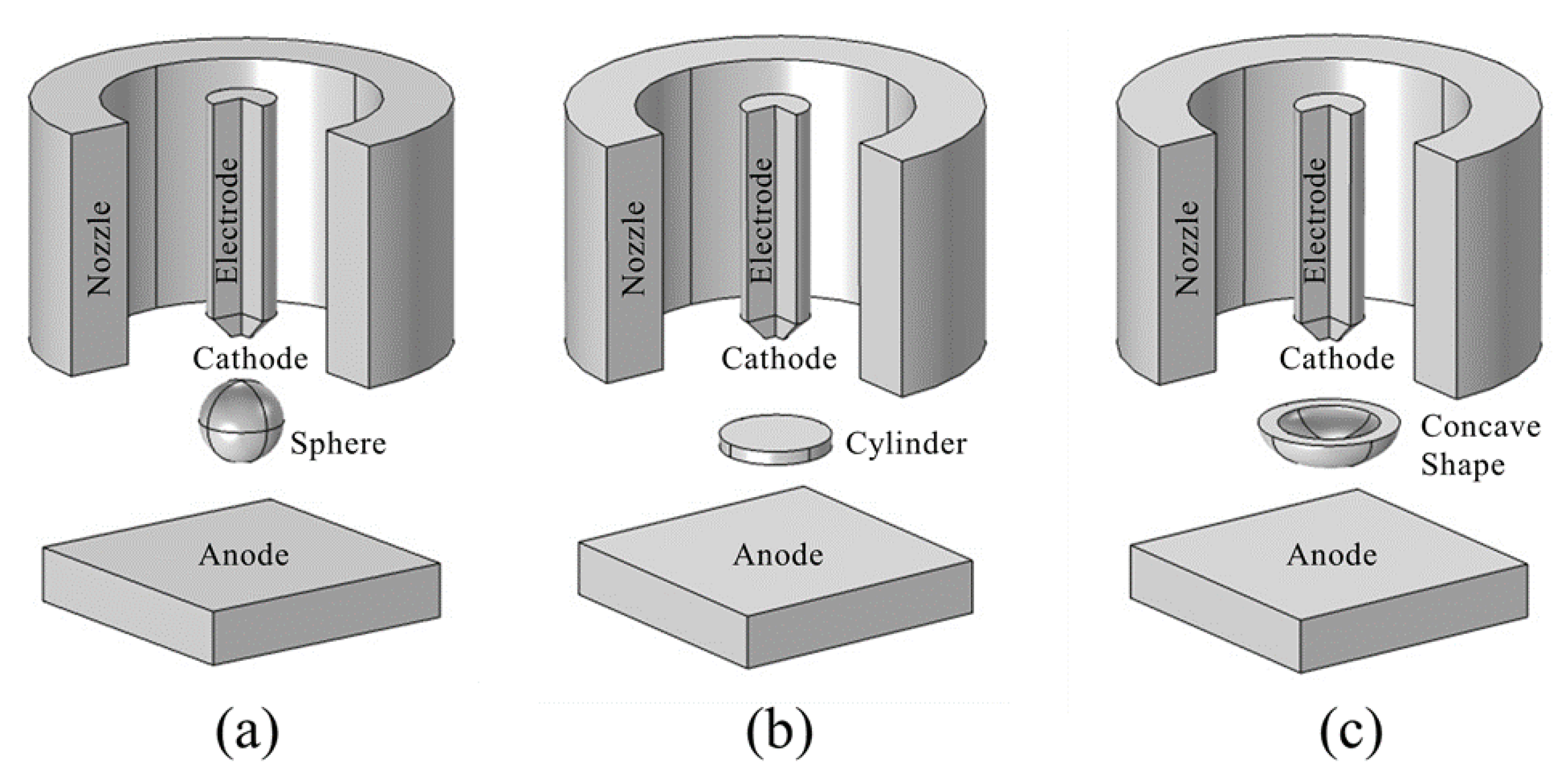


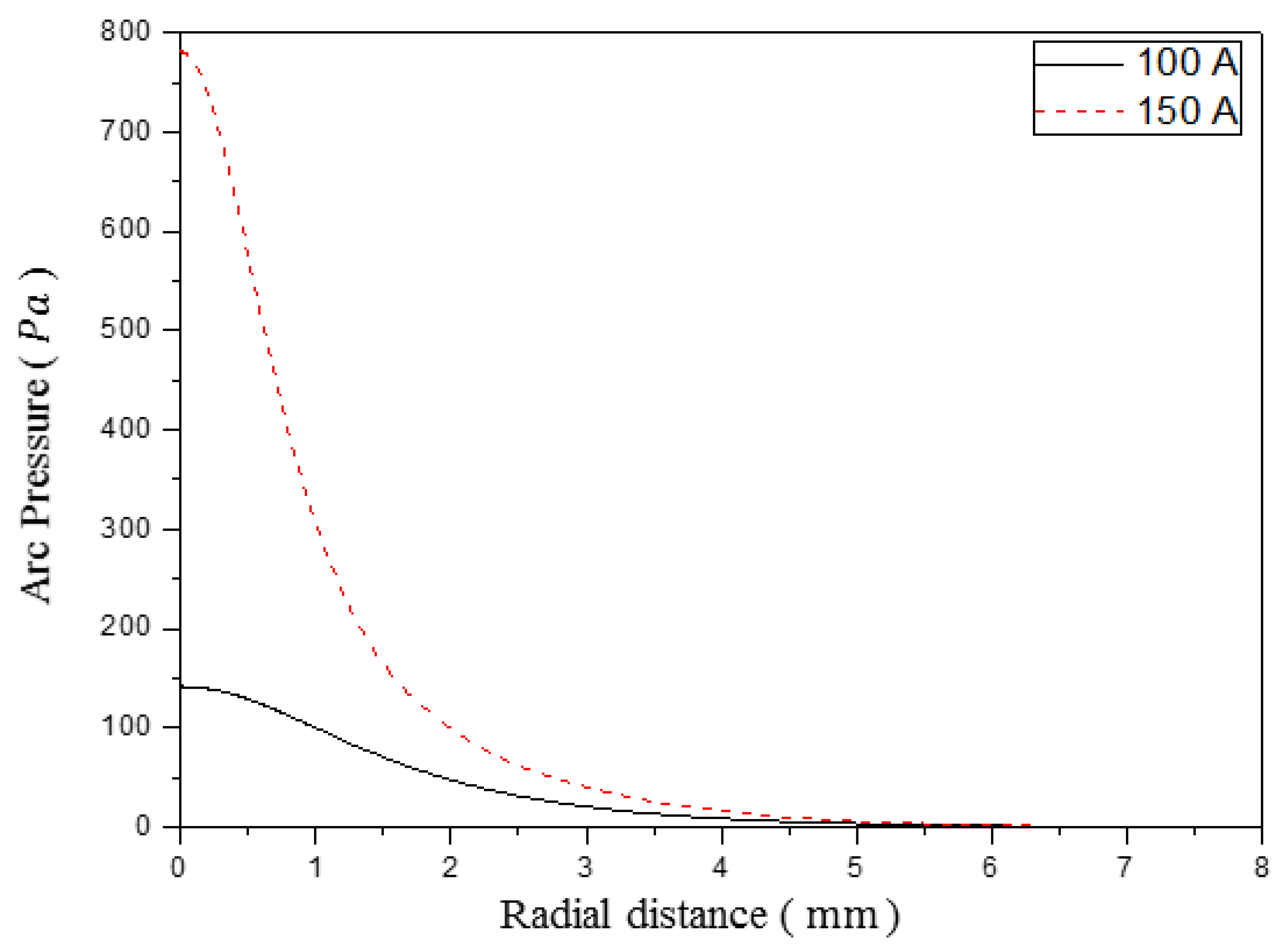


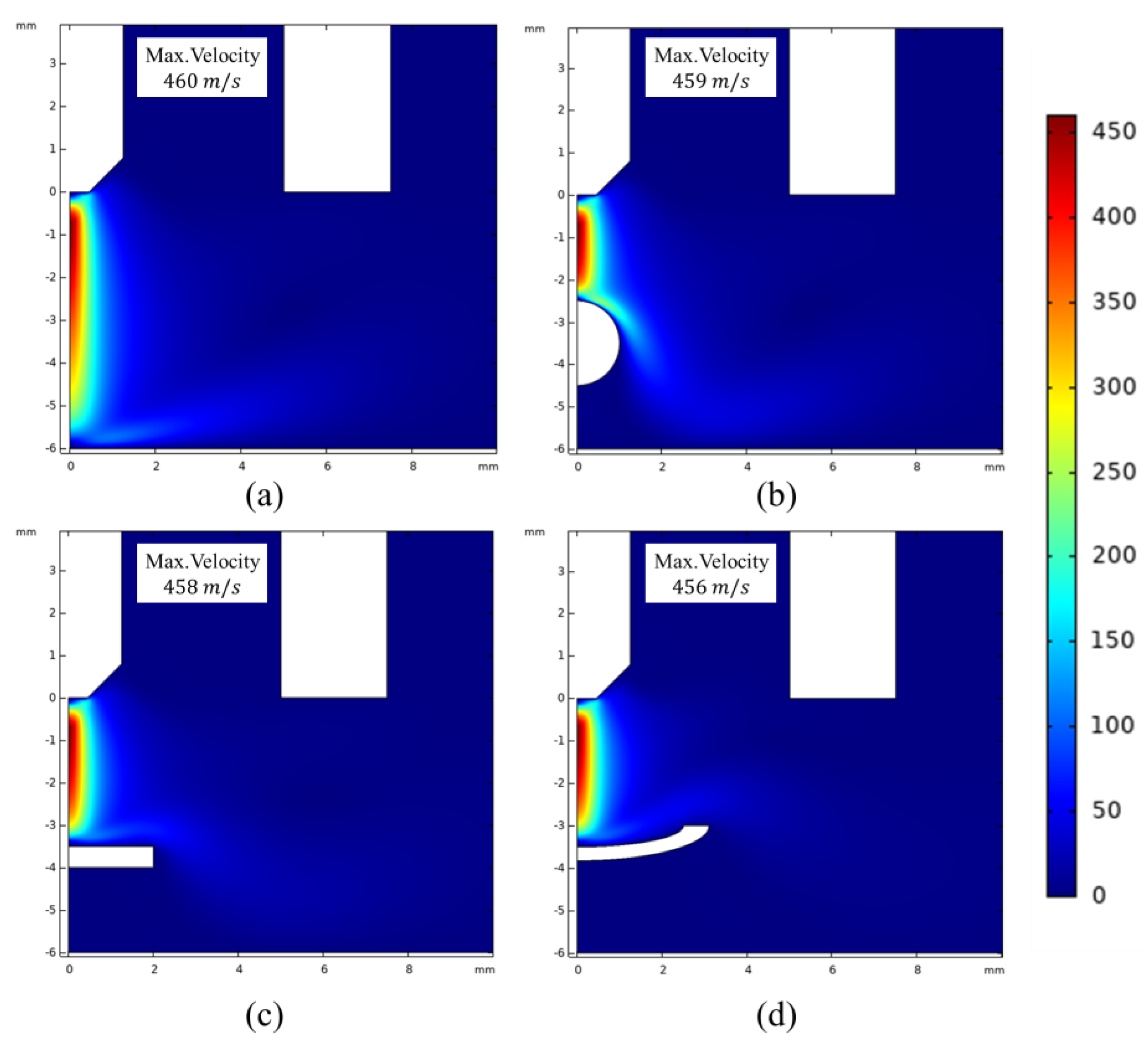
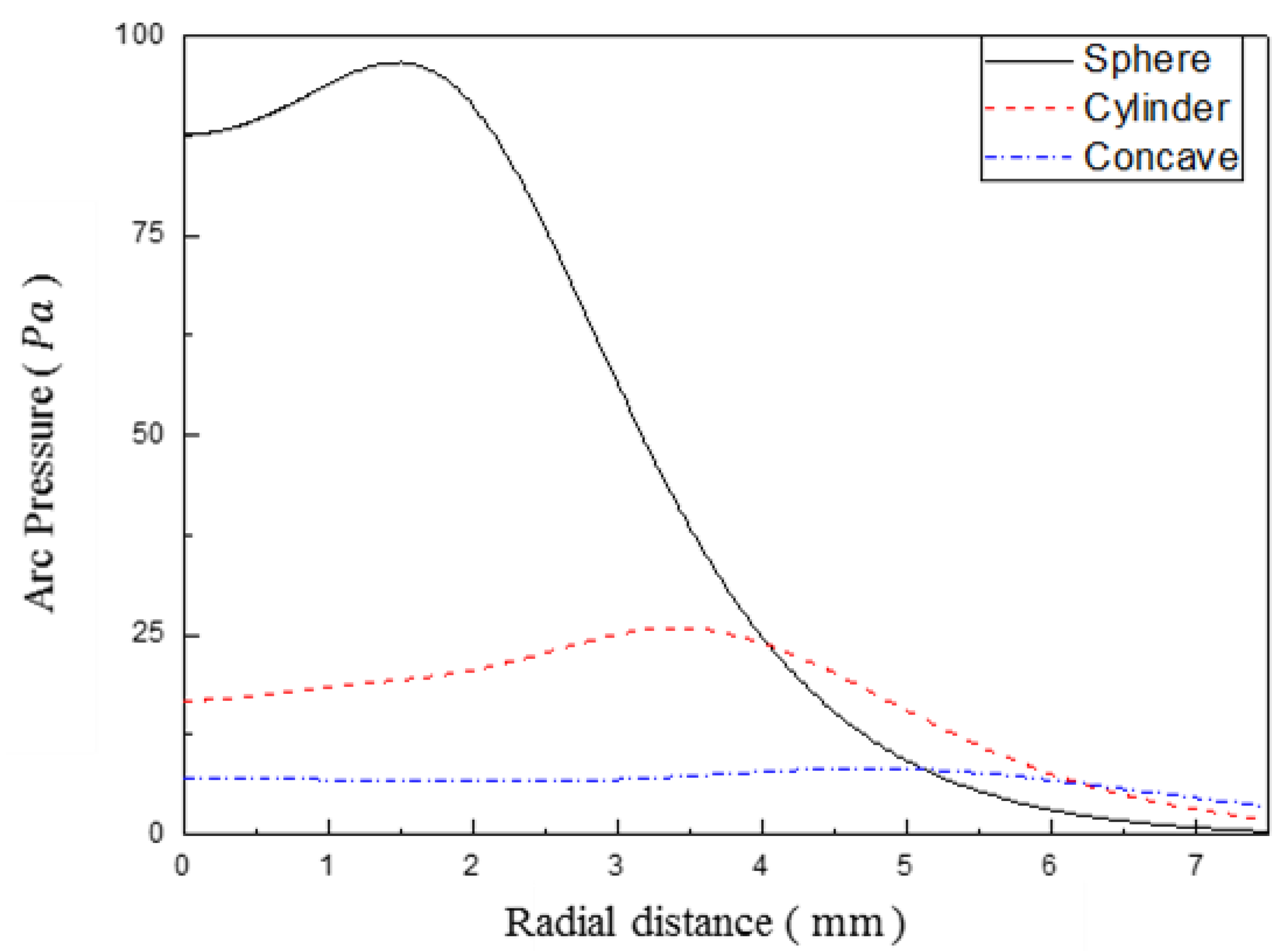
| Boundary | Equations [22] | |
|---|---|---|
| BC |
| |
| (20) | ||
| (21) | ||
| (22) | ||
| (23) | ||
| (24) | ||
| ||
| (25) | ||
| ||
| (26) | ||
| CD EF FG GH |
| |
| (27) | ||
| DE |
| |
| (28) | ||
| ||
| (29) | ||
| HI IJ |
| |
| (30) | ||
| (31) | ||
| AJ |
| |
| (32) | ||
| (33) | ||
Publisher’s Note: MDPI stays neutral with regard to jurisdictional claims in published maps and institutional affiliations. |
© 2021 by the authors. Licensee MDPI, Basel, Switzerland. This article is an open access article distributed under the terms and conditions of the Creative Commons Attribution (CC BY) license (https://creativecommons.org/licenses/by/4.0/).
Share and Cite
Cho, Y.-T.; Jeong, G.-H.; Kim, C.-K.; Kim, W.-P.; Jeong, Y.-C. Arc Plasma Flow Variation by Obstruction Structures between Anode and Cathode. Metals 2021, 11, 1416. https://doi.org/10.3390/met11091416
Cho Y-T, Jeong G-H, Kim C-K, Kim W-P, Jeong Y-C. Arc Plasma Flow Variation by Obstruction Structures between Anode and Cathode. Metals. 2021; 11(9):1416. https://doi.org/10.3390/met11091416
Chicago/Turabian StyleCho, Young-Tae, Gwang-Ho Jeong, Chan-Kyu Kim, Won-Pyo Kim, and Young-Cheol Jeong. 2021. "Arc Plasma Flow Variation by Obstruction Structures between Anode and Cathode" Metals 11, no. 9: 1416. https://doi.org/10.3390/met11091416






